
Far to the north, hidden behind merciless barriers of pack ice, lie expanses of land that cast a spell over you. Huge imaginary gates, their hinges fixed to the horizon, seem to guard these land areas. Slowly the gates swing open and you enter another world where man is insignificant amidst the awe-inspiring vastness of lonely mountains, fjords and glaciers. Louise Arner Boyd was enraptured when she first went to Svalbard by ship in 1924. She probably realized that she had found the area in the eternal ice where she could put her dream of becoming a researcher into practice in the future. But that didn’t stop her from going on an extensive polar bear hunt with friends on her second trip to the Arctic.

Louise Arner Boyd was born in sunny California in 1887 to a family of investors. At school she concentrated on subjects such as botany, geology, topography and photography to prepare herself, as she said even then, for her life as an explorer. When Louise became an orphan in 1920 and inherited the family’s entire fortune, she first traveled with friends all over Europe – and in 1924, for the first time, to Arctic waters. At that time she was already 37 years old.
The large amount of money made her independent of sponsors and quite spontaneous: When Arner Boyd was about to set off for the Arctic for the third time in 1928, she heard the news that Roald Amundsen had disappeared on a search expedition for the Italian polar explorer Umberto Nobile. Arner Boyd set off in search of Amundsen and covered 16,100 kilometres along the coasts of Franz-Joseph-Land within three months. It was unsuccessful, but Louise brought home a film and more than 20,000 photographs from this trip: these became the first tangible documents for the production of maps of the area. On another trip, she spent two months on Franz Joseph Land collecting all kinds of plants for the botanical department of the California Academy of Sciences.

Also, when she later photographed the east coast of Greenland extensively, cartographers were able to draw fairly accurate maps from it. And that, in turn, determined Louise Arner Boyd’s fate for the years during World War II: her knowledge of the coasts made her a strategic advisor on Arctic matters for the military. The Germans had set up some weather stations there and Arner Boyd’s records were the only thing the Americans could use to orient themselves in the area. Her planned book on the fjord regions of East Greenland, which was actually ready in 1935, was therefore not allowed to be published until after the war. After all: On behalf of the US Army, she investigated the influence of magnetic currents on radio communication in the Arctic.
After the war, nothing stood in the way of the explorer’s work: she used the then new technique of photogrammetry for land surveying, explored the seabed with echosounders and used them to discover and map an undersea mountain range between Bear Island and Jan Mayen Island in the Greenland Sea. The underwater mountain is now called Louise A. Boyd Bank. Along the way, she also discovered that echo sounders could be used to locate larger schools of fish: Today, this technique is used in commercial fishing.

The “Ice Woman,” as she was known, died in San Francisco on September 14, 1972, in failing health and impoverished: she had spent her entire fortune on research. At her request, her ashes were scattered in the Arctic. In memory of a woman who always dressed nobly and femininely even on the toughest expeditions, an area near the De Dee glacier in Greenland is now named after her.





